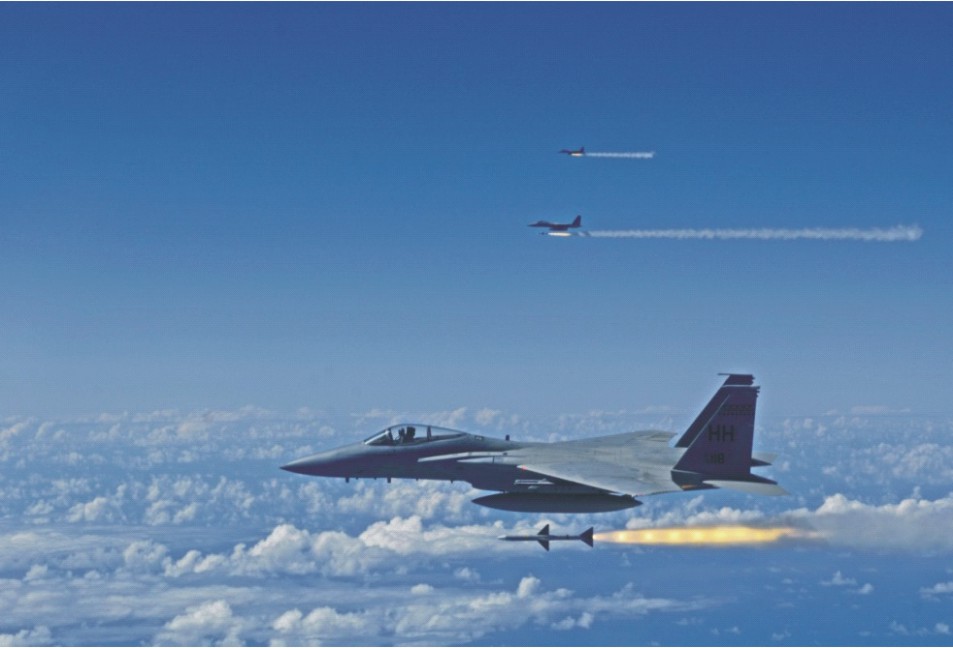Avoiding measures
Modern aircraft, if they are not to become stillborn in the cradle, have to be able to avoid being hit by increasingly more accurate, longer ranged, more lethal missiles both ground-launched as well as air-to-air.
A modern, fourth and fifth generation aircraft configured for the air defence, deep penetration strike, transportation roles or helicopters of both attack and transportation genres are designated mainly on the strength of their onboard airborne electronics. They help to detect incoming threats at long ranges and either automatically deploy counter-measures like decoys or tell the pilot in increasingly shrill notes what avoidance measure he must take to ensure that his aircraft is not hit.
Survival in the aerial battlefield of the future will be wholly dependant on onboard sensors that can warn of not just launch of missile but also the speed with which it is approaching and from which direction.
The sensors will have to be multi-functional in that since target acquisition is usually done by the use of radars-a radar that can see the intended target and activates the launch of a missile to intercept it-that moment of illumination by radar emissions needs to be discerned and recorded so that counter-measures can be chosen and deployed.
That is not going to be the end of the story. More often missiles are self-seeking predators guided to target by an active laser beam that illuminates the target or by passive means that either read the aircraft shape or sense the exhaust heat and automatically home on to target.
Safety techniques
For the intended target survival means an ability to either see or sense the approach path of the predator and avoid being hit by the deployment of chaff intended to replicate the mass of the aircraft or magnesium flares to ignite heat sources away from the actual aircraft so that the missile that depends on heat-seeking or imaging infrared techniques is fooled into believing that the decoys are the real thing.
If neither of these works the final safety device is a high-speed getaway either by using a tight U-term that would test the limits of the G-forces (gravity) that affect a moving body in space that man, machine and missile can overcome to achieve their separate ends – the aircraft’s survival or a hit by the missile.
These are functions of radar warning receivers and missile approach warners that are critical components of the entire avionics suite that is fitted into the cockpit and at selected points on the aircraft’s fuselage, wings or tailfins.
Placement of the sensors depends on the experience of using these subsystems. For example one sensor was fitted onto the leading edge of the wing but experienced what is known as “masking” and it was shifted to the nosecone to avoid that phenomenon.
Much that is happening (impressive as it is) has to be the product of the known or potential capabilities of the killer missiles that have to be overcome within split-seconds by the target aircraft.
In this task of self-defence the radar warning receiver and the missile approach warner play complementary and supplemental roles.
The proof of the pudding is seen in the efficacy of the electronic counter-measures that are deployed and, in the final analysis, how well manoeuvre tactics manage to break a lock-on situation and effect escape.
However, everything depends on how soon a threat warning is received in the cockpit and how accurate is the direction from which the threat is approaching.
A case in point, though not related to the aerial mélange, is that of the sinking of the Indian Navy Ship Khukri by a Pakistani submarine in the Arabian Sea during the war of 1971.
There was general intelligence that a submarine was lurking several hundred kilometers off the Mumbai harbor and the INS Khukri was dispatched to look for it. It appears that the submarine was sitting dead in the water with its engines shut down.
The sonar of the INS Khukri could not pick up any ‘ping’- the sound the sonar receives if its signal strikes metal.
Clearly, it did not have the range to reach the Pakistani submarine which released two torpedoes in the dead of night and the Khukri was hit and it sank with heavy loss of life.
In this case the range of the Khukri’s sonar let it down in the first instance by not detecting the submarine. This was compounded by the inability of the ship to detect the incoming torpedoes and take counter-measures-decoy or manoeuvre.
In a sea environment everything that happens is like a slow-motion enactment of an aerial battle.
Early warning
In the latter everything happens in split seconds: The radar warning receiver detects the enemy emission indicating a missile launch and sounds the warning in the cockpit. The missile approach warner takes over and gives the pilot the direction and distance of the approaching radar.
In most cases nowadays the counter-measures are released automatically when the direction and distance is established and flares and chaff are released.
At the same time the pilot is warned and prepares to manoeuvre the aircraft away from the approaching missile/aircraft by turning towards them-a very tight turn to ensure that the missile either breaks up in an attempt to follow the aircraft because of the massive gravity pull that is exerted on a maneuvering aircraft or missile and human pilot or continues harmlessly along its flight path. Either that or the pilot applies the afterburner and scoots away.
Auto-release of counter-measures has become necessary because there is an unacceptable delay between the time the pilot comprehends the warnings from the radar warning receivers and the missile approach warner and responds.
Automatic release happens through pre-determined settings given the speed of approach of missile and the distance and speed that the shrapnel would travel if the proximity fuse on the missile becomes activated. The counter-measures should be deployed well before the fuse becomes operational so that the aircraft stays out of harms way.
As far as manoeuvre by the pilot is concerned everything depends on the aerodynamics of the aircraft. Fourth and fifth generation fighter aircraft are built to withstand gravity forces of up to 18g while the pilot dressed in very efficient g-suit can take up to 9g before collapsing.
The Russians have added a superb aerodynamic method by which its fighter aircraft are able to stall in mid-air and turn abruptly in any desired direction, especially backwards to be able to either escape a chasing missile or shoot down a chasing aircraft.
India, which has four different types of Russian origin fighter aircraft in its fleet has been making its own contribution to the avionics suit of these aircraft.
At every upgrade period radar warning receivers and missile approach warner named Tarang are installed as part of a constant process of upgradation.
The Tarang has been created by a collaboration arrangement by several laboratories of the Defence Research and Development Organisation and manufactured by Hindustan Aeronautics Ltd.
It has been retrofitted on two of the older generation of fighter aircraft of the Indian Air Force fleet the MiG-27 and the British Jaguar (both of the 70s vintage) as well as the most modern Sukhoi-30 and the indigenous Tejas fighter.
There are several reasons for this: It is always better to have a system on board, the coding and encryption and operational parameters (like moment of dispersal and ignition of counter-measures) of which is indigenous.
Indeed, the survival in modern air warfare is touch and go.





